

In my view Colombia is the most beautiful country in the world.
It is also an ornithologist/bird-watcher's paradise.
Where To Go Birdwatching In Colombia
Colombia: The Most Beautiful Country On Earth?
Colombia: Green Heaven
Colombia's big comeback
PATH TO PROGRESS
How the country went from being the cocaine capital of the world to a Latin American success story.
VALLE DEL GUAMUEZ, COLOMBIA — Cradling in his hands cacao pods as red as scarlet macaws, Serafín Guzmán bends down to work the Colombian earth that has defined his life since he was a boy – producing both searing tragedy and now, he hopes, a bright future. Farmers like him stand at the heart of a story that has transformed Colombia from the world’s cocaine capital to one of Latin America’s great success stories.
A decade ago, Mr. Guzmán grew coca, the basic ingredient of cocaine, on his 200-acre spread. These days the farmer in Putumayo, a jungle region of southern Colombia bordering Ecuador, shows off flourishing rows of corn, avocados, bananas, and peppercorn plants. But it’s the squat trees laden with cacao, the basic ingredient in chocolate, that offer the most hope he has for a secure future – and that the country’s five decades of guerrilla war is over.
“There is security now. I can grow my crops and try to improve with something new like cacao in tranquility,” says the young farmer in knee-high rubber boots and a beaked cap.
Orphaned as a boy after both his parents were murdered in what Colombians simply call “the conflict,” Guzmán later became one of Colombia’s millions of internally displaced people. When he decided a few years ago it was safe enough to return to his farm, Guzmán was ready to move beyond coca plants. He found there were now government programs to help him do that. He planted 6,000 cacao trees. “I grew up in the coca culture; it was easy and brought a lot of money into this poor area, but it brought with it too much pain,” he says. “Things really have changed for the better.”
Guzmán’s shift in fortunes is emblematic of Colombia’s dramatic turnaround. Fifteen years ago, the country was considered by many a failed state. It was awash in the world’s worst violence, mired in the continent’s oldest guerrilla war that had cost nearly a quarter-million Colombian lives, with weak institutions that reached only parts of the country and were prone to the control and corruption of drug cartels or right-wing paramilitary groups. When it became clear that the presidential election of 1994 was riddled with drug money, Colombia was written off by much of the world as a dysfunctional narco-state.
But now as the country moves tantalizingly close to putting an end to its long war – the government and the Revolutionary Armed Forces of Colombia, or FARC, agreed last fall to reach a final peace accord by March 23 – Colombia is a very different place. Killings, kidnappings, and disappearances are all down sharply: Murders, which totaled 26,250 in 2001, fell by more than half to 12,750 in 2014. Bombings, field battles, and massacres are no longer daily front-page fare. With security reestablished in many places, notably cities such as the capital, Bogotá, and the Millennial-cool Medellín, private investment is flooding in and the middle class has expanded.
Perhaps most important, the central government is no longer absent from whole sections of the country, and no longer leaving a vacuum to be filled by crime gangs and other malfeasant actors.
While this progress is largely a result of Colombians’ own efforts, it was accomplished with the assistance of a partnership with the United States. And it is this collaboration, dubbed Plan Colombia at its inception in 2000 under then-President Bill Clinton, that now stands out as a success of US foreign policy, a rare case of American nation-building that worked. Other such efforts launched in subsequent years, such as those in Afghanistan and Iraq, are widely considered failures and have turned off much of official Washington to the efficacy of big state-building programs.
Given the gridlocked Washington of today, where foreign-policy initiatives are just as politically contested as domestic issues, it’s worth noting that Plan Colombia has evolved over 15 years with unwavering support from both Democratic and Republican administrations.
“It’s been a success because it’s been bipartisan,” says Daniel Restrepo, who served for six years as President Obama’s principal adviser on Latin America before joining the Center for American Progress, a think tank in Washington.
But to say that Plan Colombia worked is not to suggest that it accomplished everything it set out to do. It was initially conceived largely as an anti-narcotics collaboration, and that part of the plan was hardly a rousing success. Colombia’s drug trade was splintered but far from destroyed, while the drug cartels’ logistical control of the trade simply shifted to Mexico. And coca production, which was reduced for a time largely through a controversial US-supported aerial eradication program, has surged back in some regions in recent years.
Human rights advocates fault the plan for focusing on security and concentrating spending on military hardware: Plan Colombia has left the Colombian armed forces with the second-largest fleet of Black Hawk helicopters in the world after the US.
Still, the initiative has transformed millions of lives and helped bring state institutions – a professionalized National Police force, judicial services, and social programs such as rural development – to large swaths of formerly lawless territory. It is helping people like Guzmán support the world’s taste for chocolate instead of its desire for cocaine.
On a wall across the plaza from Casa de Nariño, Colombia’s presidential palace in Bogotá, graffiti scrawled in black spray paint declares, “Sin pan para el pobre, no hay paz para el rico” – “Without bread for the poor, there is no peace for the rich.” The phrase might sound like a slogan from the “We Are the 99 Percent” movement in the US.
But in Colombia the graffiti is an apt reflection of the country’s long war, a conflict launched in the mid-1960s with an ideology of delivering political power, justice, and economic equity to rural farmers (campesinos) through the use of force. That ideology was tainted as leftist guerrillas like the members of FARC increasingly turned to Colombia’s booming drug trade in the 1990s to finance their survival. And in recent years as the conflict has receded to the country’s vast rural areas, many Colombians have been tempted to believe that the conflict hardly mattered anymore. Declining rates of violence and sustained economic growth have left the unresolved war less and less relevant.
But other Colombians, among them some of the country’s leaders, knew that, to paraphrase the graffiti, there would be no peace, no fulfillment of the country’s potential, if poor rural regions were left behind as modern, urban Colombia moved forward. To these leaders, the path to peace starts at least with extending the security and institutions of the state to every region of the country.
To the extent that Plan Colombia has done that, it has played a crucial role in jump-starting Colombia’s progress.
Inside Casa de Nariño, Sergio Jaramillo, Colombia’s high commissioner for peace and one of the chief government negotiators at ongoing peace negotiations with the FARC in Havana, is running late. There’s a roundtable with other officials on “the future of a country in peace.” Then there’s the matter of a recent controversial rally featuring FARC leaders where weapons were provocatively displayed – a violation of the ground rules for the peace talks.
But the commissioner, who speaks in the lofty phrases of the Oxford-educated philologist that he is, takes a moment to sit down at his desk, which is strewn with papers and contains a bowl of candies that are white like Picasso’s doves of peace. What his years of experience have demonstrated to him, he says, is that state-building, or what he calls “the extension of the state’s institutional presence,” is key to creating peace and prosperity. Furthermore, he praises Plan Colombia for helping, despite its faults, in the effort to revive Colombia.
“I am not one of those who believes that Colombia in 2000 was a failed state. It wasn’t going to completely crumble,” Mr. Jaramillo says. “But there were large swaths of the country that looked like a failed state, where it certainly was an absent state. And so for me the most important question in all this is how to strengthen institutions on the ground, so they can provide order and help to manage the normal complexities of life.”
Calling Plan Colombia “a model of cooperation that is probably the most mature program of development assistance the US has ever put forward,” Jaramillo says the strength of the program was in assisting and advising the Colombians – in essence providing the seed money for a national rebuilding project – but not doing it for them.
Plan Colombia was “built on the basis of the home country taking on most of the responsibility,” the former vice minister of defense says. “The US was wise in not trying to fight the other man’s war.” He considers the US-Colombia partnership a model of nation-building. The two countries “were talking about an assistance strategy with a state-building element long before people were talking about nation-building in Afghanistan and Iraq,” he says.
Other experts in Bogotá say that if Plan Colombia succeeded, it did so almost despite itself.
“Plan Colombia was a total failure in its primary objective, which was the drug interdiction aspect,” says Sergio Uribe, a specialist in law enforcement at Universidad del Rosario in Bogotá and a longtime consultant on governance and organized crime in both Washington and Colombia. “If anything, drug production under Plan Colombia has grown, and particularly in recent years,” he says. But he quickly adds that its secondary objective, which was primarily to professionalize the military and the police and to create a viable and truly national judicial system, “had an unprogrammed effect. By forcing the government to spend money on the plan’s priorities as a requirement for keeping the assistance coming,” Mr. Uribe says, “it helped the country pull itself up by the bootstraps and build a functional state – something that until Plan Colombia we did not have.”
One example: Before Plan Colombia, a fifth-grade education was sufficient to join the National Police. But now the minimal education for a police recruit is a high school diploma. Under former President Álvaro Uribe, the country also committed to putting at least 30 police officers in each of its 1,105 municipalities – a huge extension of the state’s presence over what it was in the 1990s.
On the floor of the Ocati fruit-packing plant an hour’s drive north of Bogotá, women in smocks and hairnets sort through large bins of “uchuvas” or “golden berries,” tart, marble-sized fruit winning the hearts of chefs around the world.
The plant hums with activity as the workers cull and pack sweet-scented fruits into stacks of colorful boxes. As part of their work, they strip the uchuvas of their distinctive paperlike shells. Some of the berries will be sold domestically, but a growing share is destined for foreign markets: The greenest berries are culled for finicky Germans, and the firmest are set aside to undergo a 10-day anti-fruit-fly quarantine to win the right to enter the US.
As a tropical fruit wholesaler, Ocati is a beneficiary of the global boom in people’s quest for natural products and new tastes. The company, founded in 1988, has started selling dragon fruit to Hong Kong and guanabana to Dubai, United Arab Emirates. And these days buyers can source the cornucopia of fruits the company offers from all of Colombia’s regions and climate zones – something that was impossible just a few years ago.
“In recent years we’ve been able to grow and expand our offering of fruit varieties because we’ve been able to get to regions of the country that before were off limits,” says Wilson Amézquita, a plant operations chief at Ocati’s packinghouse in Chia, a town in the valley north of Bogotá.
To Mr. Amézquita’s way of thinking, the 15-year partnership between Colombia and the US is paying off. With less violence has come more jobs, growing salaries, and a return of foreign investment – which rose from $2 billion in 2000 to $16 billion last year. “With Plan Colombia there is more security for more of the country, and that has changed life for many Colombians, but it has also broken the uncertainty of foreign investors,” he says. “The more foreign investment there is, the more competitive and quality-oriented Colombian companies have to be – and that process of improvement has allowed companies like ours to export and take a little piece of the global cake that is the world economy.”
Colombia’s improved security climate is felt even more acutely by the women sorting and packing fruit on the ground floor. Mostly single heads of household, the women chat easily about what a safer and less violent community has meant for them. “Before you couldn’t leave here at 4 or 5 in the afternoon without fear of being robbed on the way home, and most of us are mothers and we all had so many worries about the dangers our children faced every day,” says Dorelvi Guerrero, a mother of three and Ocati employee for 23 years who is a floor supervisor. “But now security is better. That is reassuring for us. But I believe it also allows companies in the area to add more jobs, which helps everybody.”
Ms. Guerrero, who will soon complete her high school education and begin building a new house through company programs, sees another benefit of working for a firm sending Colombian fruit to foreign markets. “When you think that a lot of this is going to Europe,” she says, looking over the bins of small yellow globes, “it makes you feel part of the world.”
Not far from Guzman’s farm in southern Putumayo, the small town of El Placer sags sadly under the weight of years of violence and the indelible memory of a horrendous massacre. Many houses and small businesses on the main street are abandoned and overgrown, as a peak population of several thousand in the years of the coca boom has dwindled to less than 800.
Tall weeds and jungle vines creep inexorably to claim the walls that witnessed the town’s darkest moment 17 years ago. These days about the only sounds one hears are the shouts of police officers playing a pickup soccer match with some of El Placer’s few adolescent boys.
Two decades ago Putumayo was the No. 1 region for coca production in Colombia. The lucrative, illicit crop brought unimagined earnings to small-farm operators such as Guzmán and attracted campesinos from neighboring poor regions looking to cash in on the bonanza. They settled in places like El Placer. But violence flared as the FARC and paramilitary groups battled for control of the coca market: Thousands were murdered or disappeared, sexual violence against women became commonplace, and nearly 150,000 people were displaced from Putumayo in the decade after 2000.
At the abandoned elementary school a half block from a relatively new arrival to El Placer’s main street – a police station – the small Museum of the War records the town’s tragic history and chronicles the events of Nov. 7, 1999. On that day several dozen paramilitary fighters arrived in the town they believed was sympathetic to the FARC. The Army failed to arrive in time to stop the shooting – out of complicity, most locals insist, with the local paramilitary force. The violence left 11 villagers dead. But during the years of the coca wars about 1,500 civilians were killed in and around El Placer.
At the one-room museum, a glossy timeline of Putumayo’s war years published by international human rights groups hangs on the outside wall. The year 2000, the launch date of Plan Colombia, is marked by an American flag overlaid with a skull and crossbones. Unlike the widely positive image of the US-Colombia collaboration in Bogotá, places like El Placer hold a darker view of it. They see the joint initiative as one of death and destruction – both because of the large-scale aerial eradication program the US introduced, and because of close US cooperation with an Army that was linked with the feared paramilitaries.
“Plan Colombia was a negative for this area because the emphasis was on eradication, and while that may have reduced the coca it also damaged people’s health and left large tracts of land empty and unproductive,” says Luis Fernando Palacios, the young Green Party mayor of the Valle del Guamuez municipality that includes El Placer. “Nobody wants the return of coca, but we think there are better ways to ensure that doesn’t happen again.”
Others fault Plan Colombia for being too heavy on military spending, particularly at the outset, and for serving US purposes – a desire to reduce cocaine production – in ways that were counterproductive for Colombia. “There were a lot of different agendas on the US policy side, and they ended up working at cross purposes,” says Virginia Bouvier, a Colombia expert at the United States Institute of Peace in Washington. “The emphasis was on fumigation [eradication of coca], but that led to a lot of displacement of people that went counter to the socioeconomic goals of the plan.”
Another stain on the joint effort was recurring examples of the US collaboration inciting human rights abuses instead of reducing them. “There was some evidence that the brigades receiving the most US money were the ones that ended up being hit with accusations of the worst [human rights] violations,” says Dr. Bouvier.
But her core criticism is that Plan Colombia needed to put more weight on features such as rural economic development. And she is hopeful that, with peace on Colombia’s horizon, that shift could soon take place. “I think Peace Colombia could be a much more successful policy,” she says.
In Putumayo, Mayor Palacios echoes those words. He speaks excitedly of a new program, Integral Presence of the State in Municipalities, which aims to boost the presence of institutions in places such as Valle del Guamuez.
“This is a pilot project for the post-conflict” era, “but this is something that has to begin this year and demonstrate results to people,” he says. “Otherwise the farmers will return to coca, and nobody wants that.”
A few miles of bumpy dirt road from where Palacios speaks, Blanca Lilia Ybáñez fusses over the peppercorn plants that wind up gangling trees. Ms. Ybáñez and her husband, Jesús Alebio Portillo, show off the nascent bunches of tiny green peppercorns they hope will grow in plentiful numbers and help them overcome a painful past.
“We grew coca here before, but it didn’t make us rich like people think,” Ybáñez says. “On the contrary.” She starts to tell her family’s story but, overcome, stops to wipe her eyes and regain composure. “The violence kept getting worse, but we felt we had nowhere to turn,” she says. A cousin was killed, then her pregnant daughter’s husband. Then in 2000, Ramiro, the couple’s 15-year-old “adopted son” and laborer on their six-acre farm, was abducted by the paramilitaries and murdered. The parents fled, becoming one more family in the legions of Colombia’s displaced.
But in December 2014 Blanca and Jesús got word that Putumayo had changed. The government was assuring people they could return and live in safety. There were new programs run by state agencies, with technical assistance from the US, to help families regain legal ownership of lost farms and learn how to substitute new crops for coca. The couple came home – though without their five children, who remain too frightened to return just yet.
“We got our land back. We got money to plant a new crop and for fertilizer to help the plants grow, and we get technical advice on growing something that is new for us,” Mr. Portillo says holding a peppercorn bunch in one hand. “And I can say, we live in peace.”
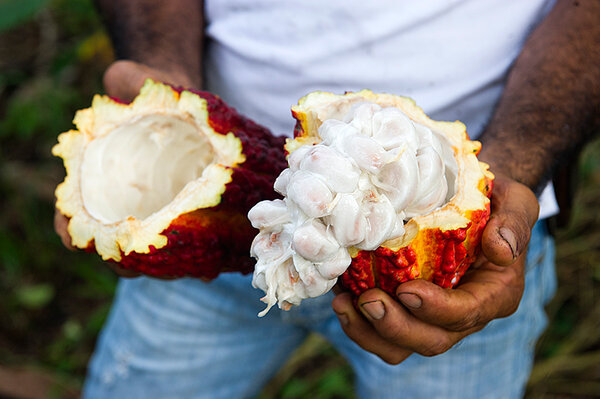
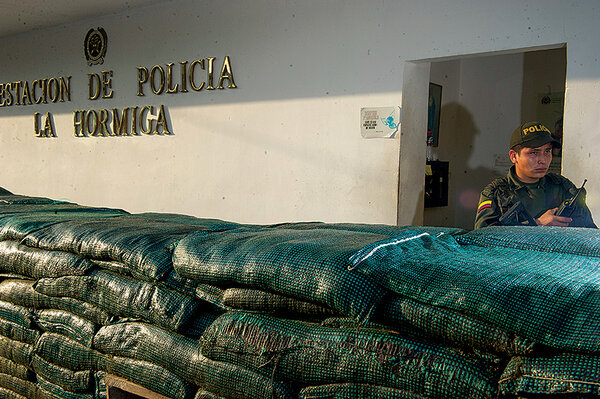

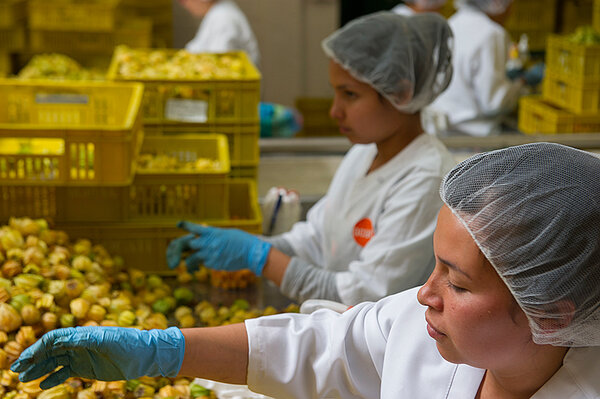
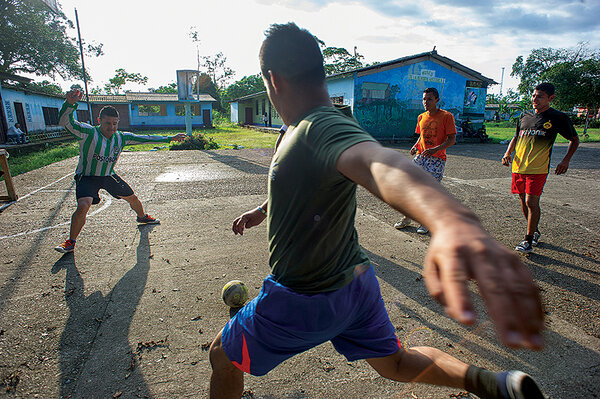
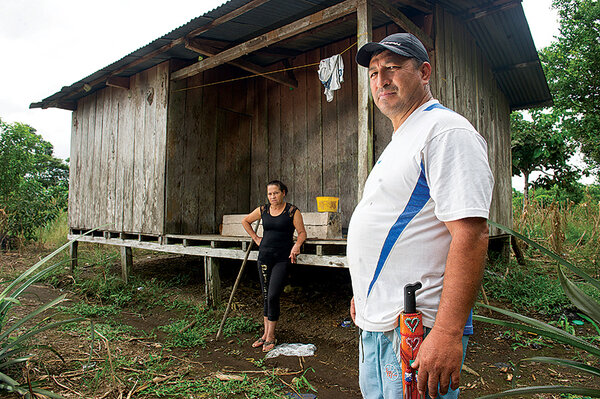

No comments:
Post a Comment